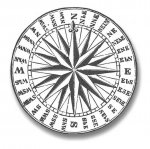emandvee44
Well-Known Member
Interesting thread. I have been doing a bit of research and found a few interesting things.
Early compass cards (preceding navigation lights) were marked in points only – no degrees. (See image) Fairly obvious, as even the best helmsman in those days, in calm conditions would not be able to steer to a degree course.
The helm orders would therefore have been in points and fractions thereof, and even in the 60’s we had to learn all thirty -two points of the compass verbatim. In fact it went further – we had to ‘box the compass’ wherein each ‘point’ was divided into four, so the first one to the East of North was ‘N ¼ E, then ‘N ½ E’ and so on.
I think it follows that when navigation lights were required to be carried and shown, which was not until the mid 1800’s, the authorities needed to specify the visible angle of the lights and they already had a points system, so combining the two was logical. Furthermore, the angle is significant to the steering and sailing rules. If you are coming up on a single white light it is (probably) a sternlight and therefore you are an overtaking vessel. If it is green or red, you are a crossing vessel. Imagine the situation if you had red and green lights with a 90 degree arc.
M.

Early compass cards (preceding navigation lights) were marked in points only – no degrees. (See image) Fairly obvious, as even the best helmsman in those days, in calm conditions would not be able to steer to a degree course.
The helm orders would therefore have been in points and fractions thereof, and even in the 60’s we had to learn all thirty -two points of the compass verbatim. In fact it went further – we had to ‘box the compass’ wherein each ‘point’ was divided into four, so the first one to the East of North was ‘N ¼ E, then ‘N ½ E’ and so on.
I think it follows that when navigation lights were required to be carried and shown, which was not until the mid 1800’s, the authorities needed to specify the visible angle of the lights and they already had a points system, so combining the two was logical. Furthermore, the angle is significant to the steering and sailing rules. If you are coming up on a single white light it is (probably) a sternlight and therefore you are an overtaking vessel. If it is green or red, you are a crossing vessel. Imagine the situation if you had red and green lights with a 90 degree arc.
M.

